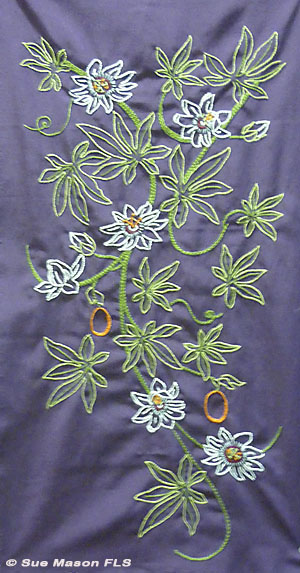The Passion Flower
Passiflora caerulea was historically used for teaching and demonstrating many symbols of Christ’s Passion. It is worked on a purple background for Lent and Advent.
“Passion” in “passion flower” refers to the passion of Jesus in Christian theology. In the 15th and 16th centuries, Spanish Christian missionaries adopted the unique physical structures of this plant, particularly the numbers of its various flower parts, as symbols of the last days of Jesus and especially his crucifixion:
 § The pointed tips of the leaves were taken to represent the Holy Lance.
§ The pointed tips of the leaves were taken to represent the Holy Lance.
- § The tendrils represent the whips used in the flagellation of Christ.
- § The ten petals and sepals represent the ten faithful apostles (excluding St. Peter the denier and Judas Iscariot the betrayer).
- § The flower’s radial filaments, which can number more than a hundred and vary from flower to flower, represent the crown of thorns.
- § The chalice-shaped ovary with its receptacle represents a hammer or the Holy Grail
- § The 3 stigmas represent the 3 nails and the 5 anthers below them the 5 wounds (four by the nails and one by the lance).
The flower has been given names related to this symbolism throughout Europe since that time. In Spain, it is known as espina de Cristo (“Christ’s thorn”). Older Germanic names[13] include Christus-Krone (“Christ’s crown”), Christus-Strauss (“Christ’s bouquet”[14]), Dorn-Krone (“crown of thorns”), Jesus-Lijden(“Jesus’ passion”), Marter (“passion”[15]) or Muttergottes-Stern (“Mother of God’s star”[16]). Wikipedia.
The Trinity is represented by the 3 bracts present around the bud. It carries the bud, the flower and the seed pod all at the same time, picturing Jesus is ‘the same yesterday, today and forever’ Hebrews 13 v 8
Revd Canon Arthur J Dobb My Embroidery
© Sue Mason FLS, 2013
<- Celebrate300 <- TOUR -> Celebration ->
